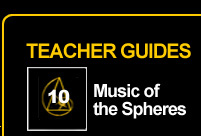






Note: This "Teacher Guide" is in the process of being updated to meet national curriculum guidelines. In the meantime, we invite you to read the subject matter below and take a look at the essay questions that your students can respond to after watching the dvd.
Of all that Pythagoras taught, he believed the act of learning was the most important of all.
Musica universalis or music of the spheres is a medieval philosophical concept that regards the proportions in the movements of the celestial bodies - the Sun, Moon and planets - as a form of musica (the medieval Latin name for music). This music was not thought of as an audible sound, but simply as a mathematical concept. The Greek philosopher Pythagoras was frequently credited with originating the concept, which stemmed from his semi-mystical, semi-mathematical philosophy and its associated system of numerology. Some of the great gurus of India considered the music of the spheres to be a term synonymous with the Shabda, the Sound Current or the Audible Life Stream, because they considered Pythagoras to be a great guru as well.
At the time, the Sun, Moon and planets were thought to revolve around the earth in their proper spheres - the most thorough and imaginative description of the concept can be found in Dante's Divine Comedy. The spheres were thought to have been created by God in proportional relations that were reflected in the whole-number relations of the pure musical intervals.
Harmony
The word harmony comes from the Greek harmonía meaning "a fastening or join". The concept of harmony dates as far back as Pythagoras.
If two notes are simultaneously played, with frequency ratios that are simple fractions (e.g. 2/1, 3/2 or 5/4), then the composite wave will still be periodic with a short period, and the combination will sound consonant. For instance, a note vibrating at 200 Hz and a note vibrating at 300 Hz (a perfect fifth, or 3/2 ratio, above 200 Hz) will add together to make a wave that repeats at 100 Hz: every 1/100 of a second, the 300 Hz wave will repeat thrice and the 200 Hz wave will repeat twice. Note that the total wave repeats at 100 Hz, but there is not actually a 100 Hz sinusoidal component present.
Additionally, the two notes will have many of the same partials. For instance, a note with a fundamental frequency of 200 Hz will have harmonics at (200,) 400, 600, 800, 1000, 1200, ...
A note with fundamental frequency of 300 Hz will have harmonics at
(300,) 600, 900, 1200, 1500, …
The two notes have the harmonics 600 and 1200 in common, and more will coincide further up the series.
The combination of composite waves with short fundamental frequencies and shared or closely related partials is what causes the sensation of harmony.
When two frequencies are near to a simple fraction, but not exact, the composite wave cycles slowly enough to hear the cancellation of the waves as a steady pulsing instead of a tone. This is called beating, and is considered to be unpleasant, or dissonant.
The frequency of beating is calculated as the difference between the frequencies of the two notes. For the example above, |200 Hz - 300 Hz| = 100 Hz. As another example, a combination of 3425 Hz and 3426 Hz would beat once per second (|3425 Hz - 3426 Hz| = 1 Hz). This follows from modulation theory.
The difference between consonance and dissonance is not clearly defined, but the higher the beat frequency, the more likely the interval to be consonant. Helmholtz proposed that maximum dissonance would arise between two pure tones when the beat rate is roughly 35 Hz.
Five-pointed Star - pentagram
The pentagram has long been associated with the planet Venus and the worship of the goddess Venus, or her equivalent. It is most likely to have originated from the observations of prehistoric astronomers. When viewed from Earth, successive inferior conjunctions of Venus plot a nearly perfect pentagram shape around the Sun every eight years.
The Pythagoreans called the pentagram ?γιεια Hygieia ("health" also the Greek goddess of health, Hygieia), and saw in the pentagram a mathematical perfection.
The five vertices were also used by the medieval neo-pythagoreans (whom one could argue were not pythagoreans at all) to represent the five Classical elements:
Hydor, water
Gaia earth
Idea or ?ερ?ν, Hieron "a divine thing"
Heile, heat (fire)
Aer, air
Heinrich Cornelius Agrippa, and others, recognized the letters as being the five beginning letters of the words: udor (water, often transliterated as hydor), ge (earth, Agrippa used gaia), idea (idea as in The Platonic Idea), eile (sometimes written as heile, heat, it meant that in the Greek known to Agrippa), and aer (air). However, note that even if one uses the "elemental" scheme that Agrippa used, it's a definite stretch because it uses heat (heile), which is not an element but a quality OF the element fire. Had Agrippa used the Attic Greek, which is the language Pythagoreans back then actually spoke and wrote, he could have used (phonetic) "empreesis" for fire or conflagration.
The ancient, and one could argue real, Pythagorean pentagram was two points up and represented the doctrine of Pentemychos. Pentemychos was the title of a work written by Pythagoras' teacher and friend Pherecydes of Syros. Pentemychos means five "recesses" or "chambers" also known as the pentagonas - the five-angle. (This is actually a lost book whose contents are preserved in Damascius de principiis, quoted in Kirk and Raven, The Pre-Socratic Philosophers, Cambridge Univ. Press, 1956, page 55). It was also the "place" where the first pre-cosmic offspring had to be put in order for the ordered cosmos to appear. The pentemychos is in Tartaros.
In very early Greek thought, Tartaros (or Chaos, according to Hesiod) was the first existing Darkness from which the cosmos is born. While it was locked away after the emergence and ordering of the cosmos, it still continued to have an influence. In fact, it was known as "the subduer of both gods and men" (Homer), and it was from this that the world got its "psyche" (soul) and its "daimon". The Boundless Darkness held influence through Mychos or Krater. Apart from being the gateway from "there" to "here" it was also a way in the opposite direction, from "here" to "there", as is evident in the many tales about how Greek heroes, philosophers and mystics descended through Krater to Tartaros/Hades (the distinction between the two was very optional back then) in quest for Wisdom. The Underworld as the source of wisdom was the rule.
Tartaros was also later seen as the "chthonic realm" where all the enemies of the cosmic order were locked away, also called the "prison-house" of Zeus. It was said to lay outside of the aither over which Zeus had lordship; what we today would call space, back then called "Zeus' defense-wall," yet it was also beneath the earth. Plato (in Cratylus) said that the aither had a penetrating power that permeates the whole world, and he found it both inside and outside of our bodies. The pentemychos is outside, or in-side, of the aither.
In the play Medea by Euripides, the sorceress Medea calls upon Hecate with the words, "By that dread queen whom I revere before all others and have chosen to share my task, by Hecate who dwells within my inmost chamber, not one of them shall wound my heart and rue it not." Note that she speaks of the Heart. The inmost chamber is the Mychos. Normally, Hecate and Persephone are portrayed as just being the rulers of the Underworld, however, Hecate is called the Lady of Tartaros, Phulada (Guardian), Propulaia (Before the Gates), Kleidophoros (Key-bearer) and Kleidoukhos (Key-holder, Priestess) - but this Underworld of the Greeks and Pythagoreans is also the "inmost chamber" and the Core of Inner Being.
In the image above of the two points up pentagram from Agrippa's book, the notion of Health that is within and inside a living being, is "bounded between the rings". According to myth, Tartaros was locked away by iron (fashioned by Zeus) and bronze (fashioned by Zeus' brother Poseidon). The iron of Zeus is the aither spoken of earlier ("space") and the bronze is demiurgos, or the waterforce which binds things into matter (Poseidon was often referred to as "he who shakens the earth" and the god Proteus, who carries the seals of Poseidon has ever since Antiquity been seen as a representation of matter.) To sum it up; even if seen as the medieval elements, Living Things are the things traveling the Wheel of Life, and not directly connected to or part of the Pythagorean pentagram itself, which is at their core in the center, a Core of Inner Being (the "soul" of "the stuff"). When one had Health, they were considered Zoös and in their hearts there was Eros (the word did not mean "erotic" in the sense we mean it today at all). To not have Health was to be Thanatos - a word that does not exactly mean dead as in "dead and buried," but means dead inside but alive, like a shell.
This is an esoteric connection, but note that the Core is the Greek Goddess Kore (another name for Persephone, alongside Hecate queen of the underworld), whose symbol was the apple. If you cut an apple transversally through its core, it reveals a pentagram. The apple is also still, despite Christian ideas over the years, a symbol of health. (An apple a day keeps the doctor away.) .
This article is licensed under the GNU Free Documentation License. It uses material from the Wikipedia article "Music of the Spheres", Wikipedia article "Harmony",and Wikipedia article "Pentagram".




